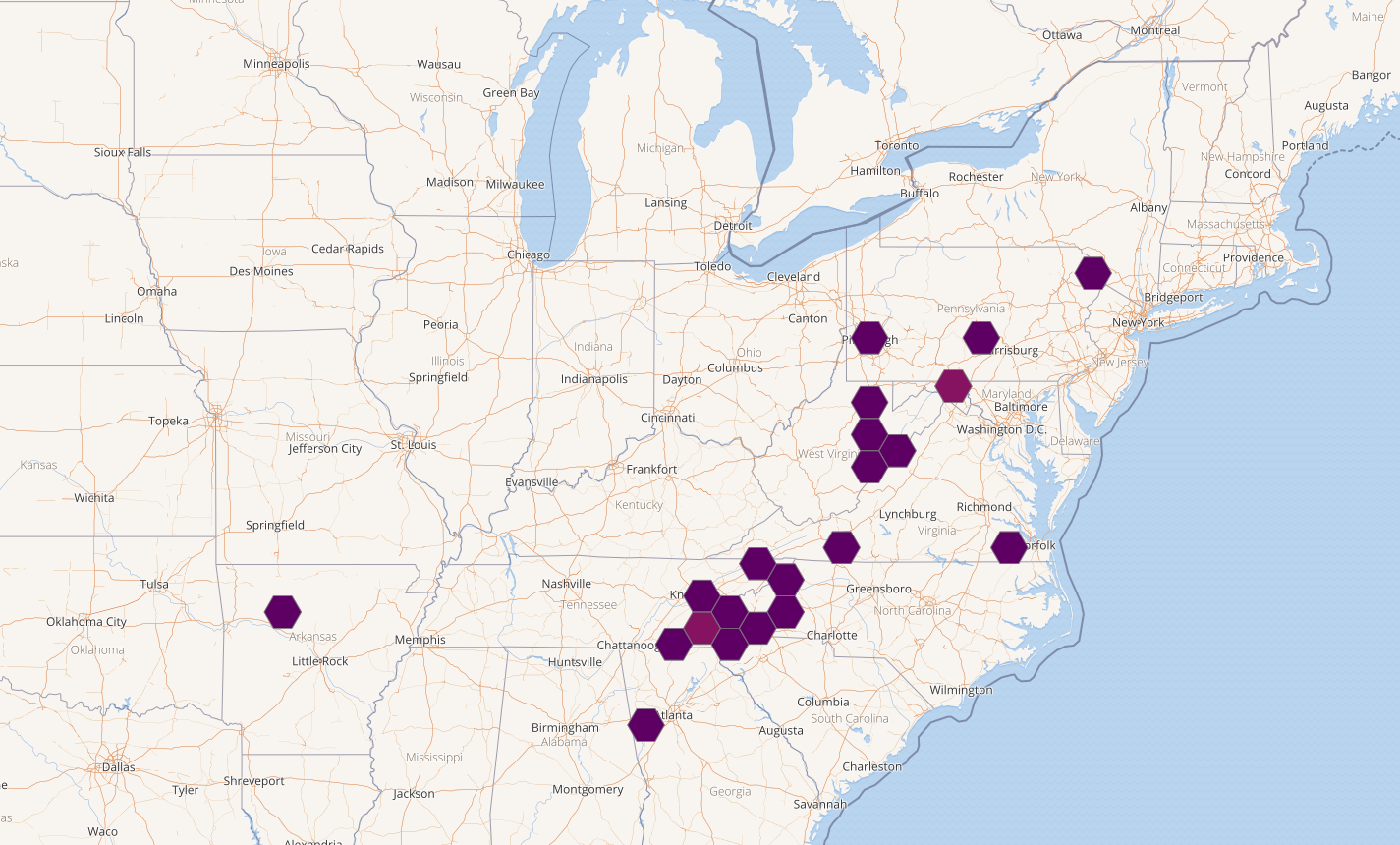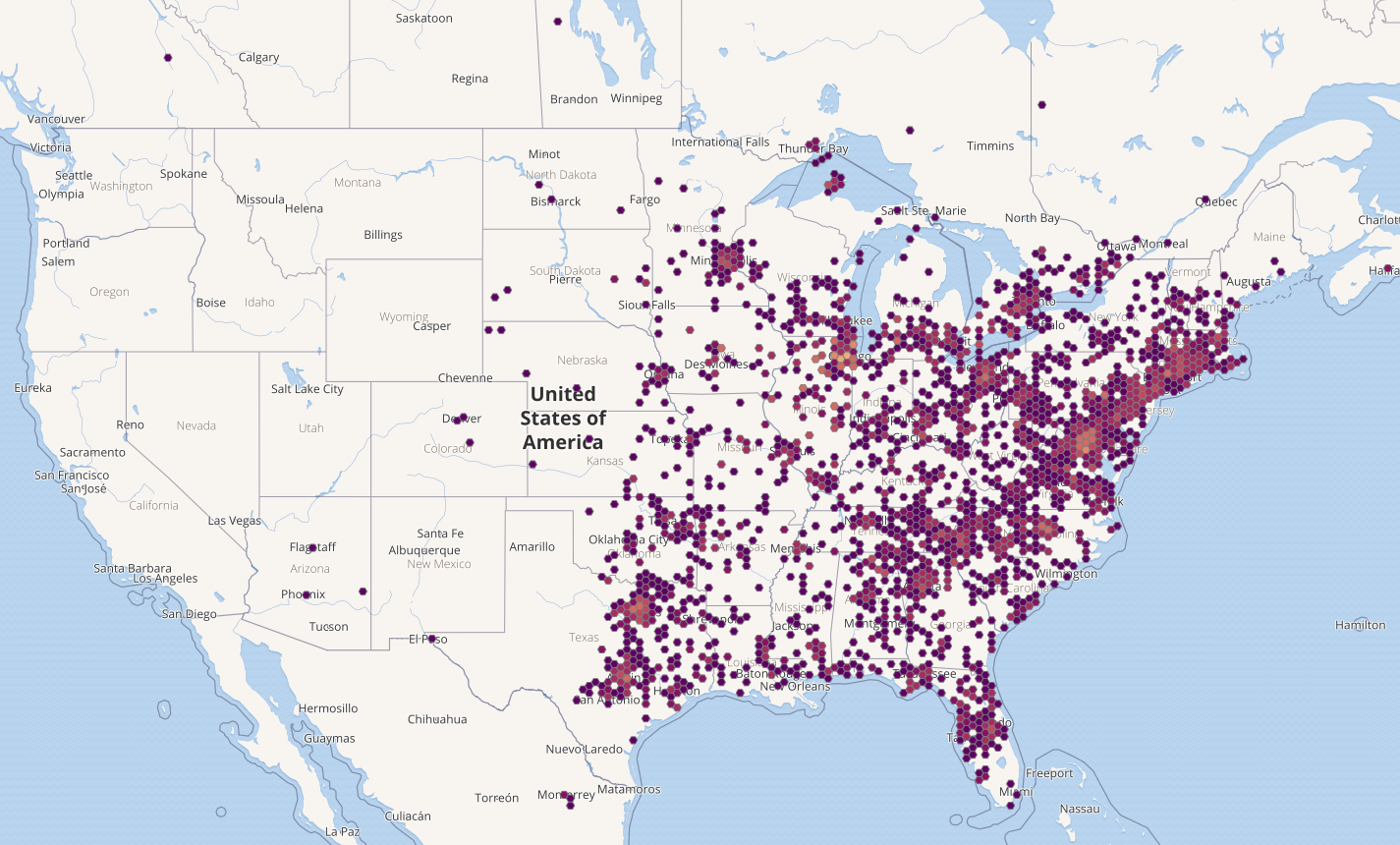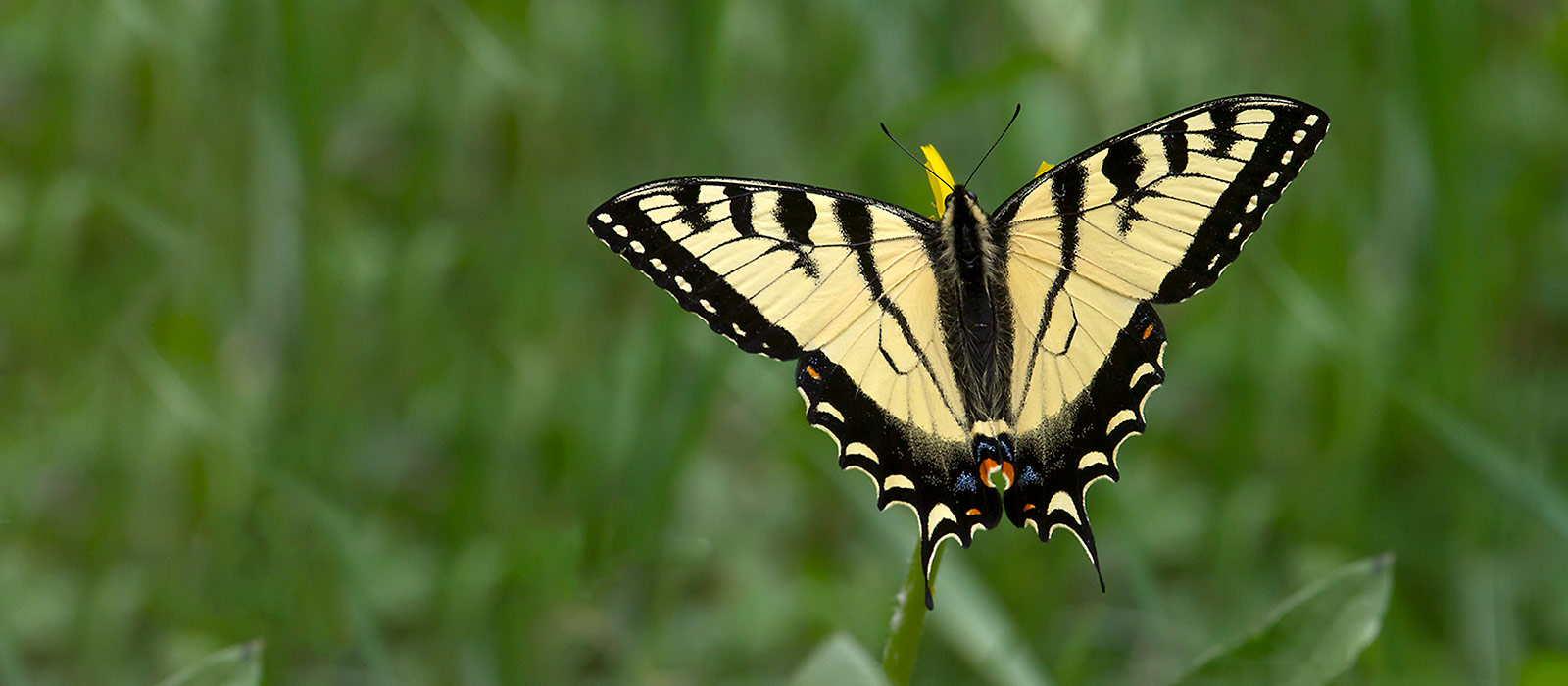
Taming the Tigers
An Identification Guide to Canadian and
Eastern Tiger Swallowtails and their Intergrades
One of the most magnificent butterflies of spring, showy in flight and unmistakeable in its markings, is also a magnificent source of mistaken identity. While most of North America claims only one tiger swallowtail species, here in the Northeast we get as many as three. Lucky us. It means that we have to use our brains a bit more to figure them out.
So here is your guide to taming these tigers. I’ll begin by presenting the three eastern species merely by their distribution maps because, frankly, to most people (but soon not you among them) the three all look alike. (Maps courtesy of GBIF.[1])
Differentiating Canadian and Eastern Tiger Swallowtails
Across vast regions of their respective ranges, Canadian and Eastern tiger swallowtails do not overlap — and therefore can be identified with ease. Although we don’t like to define species strictly by their ranges, it’s safe to say that if you’re in Alabama it’s an Eastern Tiger and if you’re in Alberta it’s a Canadian Tiger.
Identification becomes more complicated where the two ranges overlap or intersect: a zone generally stretching from New England through southern Ontario and into the Upper Midwest. Moreover, in the overlap zone we get hybrids (that we do not call Appalachian Tiger Swallowtails).
So, first, here below are essential distinguishing marks for Canadian and Eastern tiger swallowtails, including some you won’t find in field guides. The best marks are ventral (viewed from below). Dorsal-only identification can be fraught (more on this later).
Yeah, But …
So maybe this isn’t so complicated after all? Just get yourself a decent look at the tiger’s underparts. Well, uh, this is entomology, after all, which is nothing if not replete with wonderful complications. Here’s the problem: tiger swallowtails vary in appearance for various reasons, including where they live and perhaps what they ate as caterpillars. That Eastern Tiger Swallowtail above, for example, shows clear and extreme examples of most diagnostic marks. In truth, in the field, these two species can look more alike than what I’ve shown.
Early-spring Eastern Tigers Swallowtails, for example, look more like Canadian Tiger Swallowtails. And up here in northern New England, where Canadian Tiger Swallowtails dominate, we see introgression of Eastern Tiger Swallowtail genes. Basically the two species show mixed genetics owing to hybridization and other gene flow in our zone of overlap. And those in-betweeners seem to be becoming more common.
Finally, those ventral field marks do not express themselves dorsally, which is how lots of people see and photograph these butterflies. As a result, on iNaturalist (where I hang out and you should too) tigers are sometimes identified incorrectly based solely on dorsal photos. (So those of us vetting iNat butterfly records need to be more careful, and in some cases probably shouldn’t rely on dorsal views alone.)
There’s lots more to say and learn and read on these tigers, particularly this hybridization business (some of which you’ll find in the readings list below). For now, however, here are more image pairs: Canadians on the left and Easterns on the right. That final row of images, each from Vermont, shows tigers with apparent mixed lineages. It’s probably best to click and read captions rather than mouse-over, and then use your arrow keys to move forward or backward through images. (I’ll add dorsal identification advice and images at a later date.)
Canadian Tigers Swallowtails
(Papilio canadensis)
Eastern Tigers Swallowtails
(Papilio glaucus)
All four ventral marks show well on this Canadian Tiger from Manitoba on 14 Jun 2016 by Deanna Dodgson
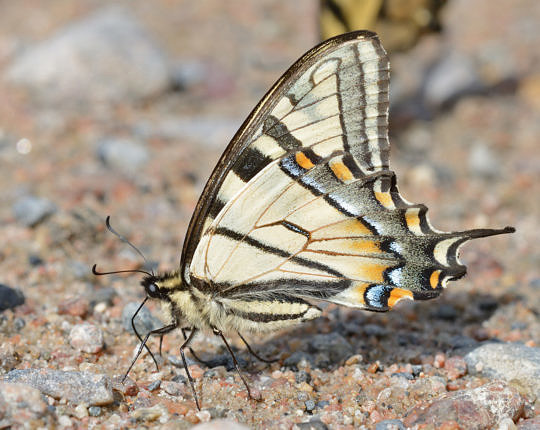
Classic Eastern Tiger marks: the yellow marginal spots on the hindwing are more typical — not quite as crescent-shaped — than on my marked-up example above / This one is from Georgia on 5 Jun 2019 / © Lisa Kimmerling
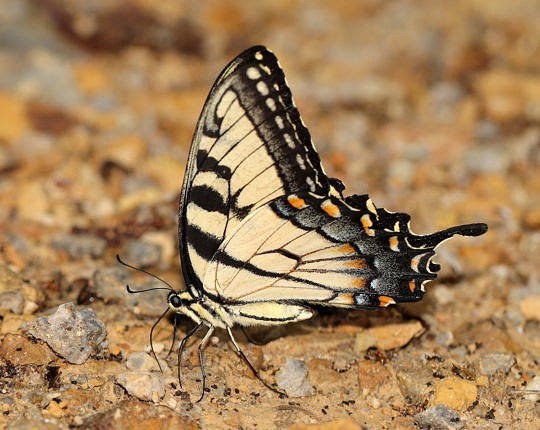
Canadian Tiger from Vermont on 30 May 2018 / © Susan Elliott / Note the clean, unmarked submarginal band on the ventral forewing. Also note how the dorsal side of that band is broken by black, which can shine through in backlit situations and make the ventral side seem broken by black (as in my marked up image above).

Eastern Tiger showing all the marks from Texas on 19 May 2019 / Check out the classic broken submarginal yellow band / © Ruthanne Thomas (via Creative Commons and iNaturalist)
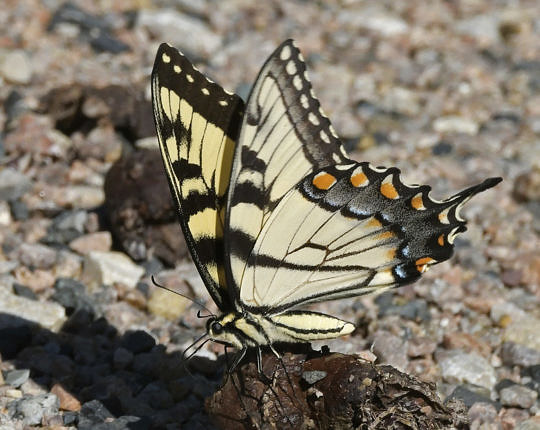
If you click and open this image, the tiger on the right, of mixed lineage, shows "in-betweener" characteristics: a bit of black intruding into that yellow, submarginal forewing band; a relatively thin black line on the trailing hindwing (near the abdomen); and slightly more crescent-like markings on the hind wing. Sue Elliott photographed this in Vermont on 12 Jun 2018.
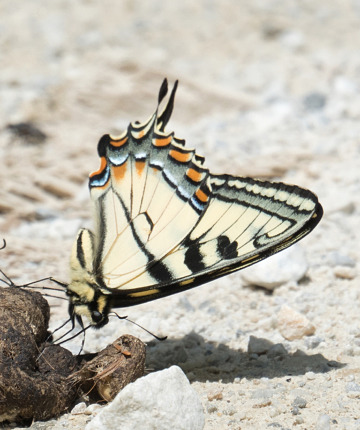
The tiger front and center show a relatively thin black line on the trailing hindwing (along the abdomen) and black intruding into the yellow submarginal band on the forewing. Sue Elliott (who has a knack for finding these) photographed it in Vermont on 16 Jul 2017.
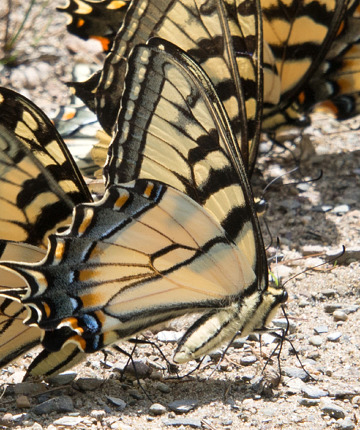
Note the thick black line on the trailing hindwing (along the abdomen), which is fine for Canadian Tiger Swallowtail, but also the intruding black into the yellow submarginal band on the forewing, which is more characteristic of Eastern Tiger Swallowtail. Erika Mitchell photographed this in Vermont on 10 Jul 2017.

Readings
- An Update on Tiger Swallowtails in Ontario by Xi Wang — This six-page PDF is an excellent backgrounder, with images, published online at OntarioInsects.org by the good folks at the Toronto Entomologists’ Association.
- A Tale of (more than) 2 Butterflies – The Science Daily news account of Appalachian Tiger Swallowtail (Papilio appalachiensis), the hybrid species.
- Pterourus Appalachiensis (Papilionidae: Papilioninae), a New Swallowtail Butterfly from the Appalachian Region of the United States – This is the original description of the hybrid species by Harry Pavulaan and David M. Wright (each of whom has forgotten more than I will ever know about these butterflies).
References and Resources
- [1] GBIF: The Global Biodiversity Information Facility (2019) What is GBIF?. Available from https://www.gbif.org/what-is-gbif [13 August 2018].
- The Vermont Butterfly Survey – Find species accounts, including range maps and flight periods, from this statewide atlas project run by the Vermont Center for Ecostudies.
- Butterflies of the East Coast: An Observer’s Guide by Rich Cech and Guy Tudor, a masterpiece this is now for some insane reason out of print from Princeton University Press.
- From the Butterflies of Canada website: Eastern Tiger Swallowtail and Canadian Tiger Swallowtail.
Acknowledgments and Disclaimer
This page could not exist without field photographers whose images you see here, including John Sutton (VT), Marty Silver (TN), Lisa Kimmerling (GA), Susan Elliott (VT), Erika Mitchell (VT), Ruthanne Thomas (TX), and Deanna Dodgson (MB). Credit also goes to Kent McFarland, Rick Cavasin, and especially to David Hoag, a meticulous lepidopterist here in Vermont if there ever was one. Any errors here are entirely mine — and not theirs. Final gratitude goes to iNaturalist — a rare example of nature, citizen-science, social networking, and the internet that does not seem to be getting a select few individuals and investors (mostly privileged white guys) filthy rich.
Published first on 20 Jun 2019, this is Version 1.0 of this page. It probably has errors, which I will correct as they are brought to my attention. I also recognize that this is an incomplete tale of these swallowtails, lacking details on Papilio appalachiensis and other hybrids, particularly this hybrid flight we’re seeing in summertime in the overlap zone.
Next up in this series: Phyciodes (Crescents), an adventure from which I may not survive. My previous publication of this ilk features our Celestrina (Azures), something called Getting the Blues.

